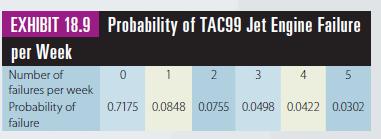Ceva, Inc. manufactures and services jet engines for air carriers. The engines cost ($10) to ($40) million
Question:
Ceva, Inc. manufactures and services jet engines for air carriers. The engines cost \($10\) to \($40\) million each, depending on the specifications and plane. A 10-year service contract for a single engine is more than the initial cost of the engine. The goals for Ceva’s scheduled preventive maintenance program for the TAC99 turbine engine are to (1) assure the safety of all air passengers by ensuring that the engine is in top-notch operating condition, (2) minimize total maintenance and repair costs over the engines operating life, and (3) minimize engine downtime because of repairs and maintenance. Major engine overhauls for the TAC99 engine are done every 3,000 flight cycles, based on design specifications and the analyses of massive amounts of data on the engine performance. Big data analyses and simulations using “digital twins” are key tools for understanding engine capabilities and maintenance and repair schedules. For the overhaul, the engine is removed from the airplane, all 2,000 parts are disassembled and inspected, worn parts are replaced, software is tested, and the engine is reassembled. Between major overhauls, routine preventive maintenance is performed, including checking a multitude of items such as hydraulic seals and lines, filters, oil and lubricate fluid leaks and levels, metal failure cracks, pumps, and software maintenance, updates, and testing. If a problem is found, it is fixed. Typical problems include pump pressure test failures, worn nozzles, cracked or kinked hoses, and clogged filters. Antoine Barlow, a data analyst for Ceva, wants to evaluate the cost effectiveness of the scheduled preventive maintenance plan. Antoine had collected the following performance data about TAC99’s performance. His data analyses determined that it cost \($3,658\) per week to do preventive maintenance on the TAC99 engine, including labor, replacement parts, testing, and software upgrades. He also determined the following probabilities of engine failure shown in Exhibit 18.9. He included two cost estimates into his “total cost of failure for the TAC99 engine.” The first estimate was the actual cost to fix a noncatastrophic failure at \($4,420\) per week. The second catastrophic cost estimate included an estimate of Ceva’s liability cost of a plane crashing, a plane sitting idle while the engine is removed, and/or if the plane had to land at the nearest airport in an emergency. For this second estimate, Antoine’s data analysis determined based on past cash payouts and settlements, the cost of rebooking passengers that land at an emergency airport, and the cost of lost customer goodwill amounts to a catastrophic cost of failure estimate of \($5,000\) per week. He also computed the probability of occurrence for these two types of failure costs, to arrive at a total expected failure cost of \($9,420\) (\($4,420\) + \($5,000)\) per week.

Case Questions for Discussion:
1.Explain how the four basic principles of lean operations apply to doing preventive maintenance for the TAC99 jet engine out in the field?
2.What is the expected cost of a TAC99 jet engine failure?
3.Is the preventive maintenance program for the TAC99 engine cost effective? Explain your reasoning.
Step by Step Answer:

Operations And Supply Chain Management
ISBN: 9780357901649
3rd Edition
Authors: David A. Collier; James Evans





